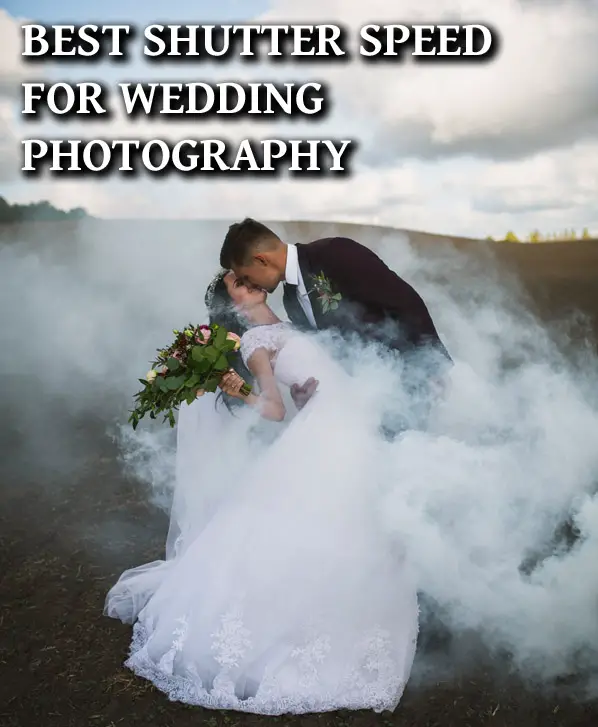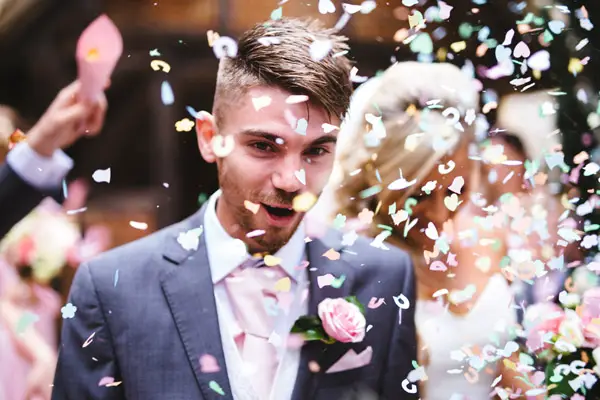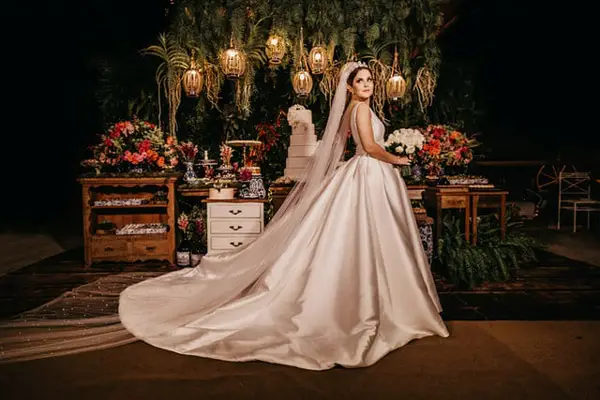Using the Best Shutter Speed for Wedding Photography?
Wedding photography is possibly one of the most difficult and demanding areas of the industry. Things are happening all around you and it’s your job to ensure that you capture the moment perfectly, or risk ruining someone’s big day. Your photographs are going to be the memories that the couple, their families, and their friends hold on to.

Getting the settings on your camera right is critical—especially the shutter speed. Let’s discuss the best shutter speed for weddings.
Generally for weddings you should stay above 1/100 for shutter speed due to the one chance to shoot nature of wedding photography, but many professional wedding photographers choose 1/60 for posed photos for better depth of field, and slow shutter speeds may be used when getting creative for slight motion blur. Let’s explain.
You want to ensure that the image is exactly what you intended so that you can edit it to perfection when you get to postproduction. There’s nothing worse than a soft photograph when you want something sharp. There’s just no way to recover the detail in the image. This is where choosing the right shutter speed for your images comes into play.
Essentially, shutter speed is responsible for how much light gets let into the camera, as well as how long the shutter stays open. The faster the speed, the less light that gets in and the less time it takes for the photograph to get captured. The slower the speed, the more light that can get in and the longer it takes to capture the image.
What is Shutter Speed and Why is it so Important?
Shutter speed is how fast the shutter opens and closes each time you take a photograph. The shutter of the camera is the covering that sits behind the lens but over the sensor in a digital camera or the film in a traditional camera. The shutter can be plastic, metal or even cloth depending on what kind of camera you have. When you press the button on the camera to take a picture, the shutter opens to let light onto the sensor or film and then closes again. This is also referred to as exposure time.
The reason that shutter speed is so important is because it dictates a large part of the exposure of your image.
Light is a key ingredient in photography, after all.
A longer exposure—or a slower shutter speed—means more light and therefore, a brighter image. Although there are other elements such as ISO and F stop that impact exposure, shutter speed is usually the first element that gets set.
The reason you go to shutter speed settings first is that as well as dictating how much light is let into the shot, shutter speed dictates how much motion blur is captured. If your subject is moving and the shutter speed is slow, you’re going to see a motion trail. This can be a great effect when done intentionally. However, this can also lead to images that are just a little blurry and don’t look so good.
This is why getting the right shutter speed for your wedding photography is so important. You are very unlikely to get an opportunity to capture a photograph a second time, meaning you need to get it right each time you press the shutter button.

1/100 or Faster for a Wedding?
Shutter speed is measured in seconds or fractions of a second. 1/100 means that the shutter is open for one one hundredth of a second. This is considered a fast shutter speed, and wedding photographers all over the world use it to capture in-the-moment photographs on the big day. The reason this is a good shutter speed is that it lets in a fair amount of light, but it’s still fast enough to freeze the action.
With a shutter speed of 1/100 or faster, you can capture details like confetti falling around the couple as they exit the church, the moment the bride tosses the bouquet, and the joy in the couple’s faces as they take their first dance. These are moments that the couple will want to remember in photographs. But you won’t be able to ask them to stop and pose or to do the action again if your image is blurry.
It’s also important to remember that wedding photography is also usually done on the move—aside from the official portraits, of course. You’re going to be roaming the ceremony and the reception, looking for the perfect moments to capture. This means that your camera won’t be on a tripod and you’ll need a shutter speed that can account for any movements in your hands. Again, 1/100 or faster will work perfectly for handheld photography.
Shutter Speed with Flash – What to Keep in Mind
When working with a fast shutter speed, you need to have plenty of light on your subject. If you don’t, you’ll have to use a wider aperture (F stop) and a high ISO value. This means your image could end up grainy or not have the depth of field you want. One way to get around this is to incorporate a flash into your wedding photography gear.
Every camera will have a flash built into the body, and that flash is often enough to give you that snap of light you need. However, an external flash can give you a lot more flexibility, especially if it’s one that’s controlled wirelessly. You could set it up closer to your subject or on a side of the room with less light to fill in your subject from a different angle.
Having a flash with you is a great idea as weddings are very often going to be lowlight situations, especially if the ceremony is indoors and the reception is at night. It’s important, however, to use your flash sparingly because the sudden light can disrupt the scene and the mood of the couple and the guests. You probably want to keep the flash on hand, but use it as a last resort when you can’t get a decent balance for exposure and keep your shutter speed fast enough.
Why 1/60th for Weddings?
A shutter speed of 1/60 is a great one to use for the staged photographs you take during a wedding. This is most likely when you have just the couple, the families, and the bridal party, and you’re using your tripod for extra stability. Going with this shutter speed gives you more room to play around with your F stop and your depth of field.
Experienced wedding photographers will often go for 1/60 if they are struggling to get enough light on their photographs. However, this is only if they know their equipment well and trust themselves to take steady shots. Image stabilizers are a big help in these situations. Many Canon and Nikon lenses come with stabilizing technology in them, making these brands a good choice.
Just remember, if you go any slower than 1/60, you’re going to see some motion blur if anyone moves at all while the photograph is being taken. You could even get motion blur from you pressing the shutter button. This is when an external shutter button and a tripod come in handy.

Using Slow Shutter Speeds at Weddings
There’s always room for getting creative with shutter speed at a wedding. Yes, it’s important to make sure you capture the important moments with crystal clear sharpness. No couple wants only creative shots with blurred movements and bokeh light trails. They’ll most likely want a balance of the two, especially when it comes to the bride showing off her wedding dress.
There are several great ways you can implement a slow-motion blur that will enhance some of your photographs and give the couple a special memento. One way to do it is with a slow sync on your flash. You’ll need to put your camera onto Shutter Priority (or TV mode for a Canon) and slow your shutter speed to 1/30 to start with. It’s possible to slow your shutter speed even further as you experiment. You can use either the on-camera flash or an external flash. An external flash is more powerful so you can be further away from your subject.
With this setup, the center of your image will stay sharp and everything around it will have a slight motion blur to it. You can try this as the bride comes down the aisle or as the couple does their first dance together.
If you’d like to know more about this technique, check out this video:
Other Settings to Consider
Wedding photography isn’t just about your shutter speed. There are plenty of other settings that you need to consider on your camera too:
- Aperture – This is your F stop and the wider it is, the more light gets let in with each shot you take. However, the aperture also controls the depth of field in your photograph, which dictates how much of the background is in focus. The wider the aperture, the blurrier the background will be and vice versa.
- White Balance – Due to the fact that you’re likely to be moving to different locations and lighting situations throughout the day, it might be a lot easier to set your camera to auto white balance. You can do color corrections in post production if the dress isn’t looking white enough or skin tones aren’t quite right. If you get the chance, however, you could go to the different locations and do a quick test of the lighting and dial in some white balance numbers that you can then switch between when you’re capturing the events.
- Focal Length – You should either have a zoom lens that allows you to change your focal length, or have at least three different set lenses in your kit. The lengths you want are 35mm for the group shots or the wider shots, 85mm for portraits, and 100m for macro shots of details.
- ISO – It’s important to keep this as low as possible because as soon as you go over 800, you will likely get some noise or grain in your photographs. Remember, these pictures will likely get printed out and blown up, so any grain will show up immediately in a large print.
- Focus – Autofocus can be your best friend when shooting a wedding. You might not always have time to adjust your camera’s focus manually as the action is happening. If your camera has an AI focus function or a focus tracking function, this is the option you want to use.
- Drive Mode – This is the setting that determines how many photographs get taken when you press the shutter button. A continuous drive mode is best for action shots – the couple walking down the aisle, people dancing at the reception, etc. You can then pick the best shot from the group.
- Image Format – You always want to shoot in RAW because this gives you a file that you can do a lot more with in post production. With a RAW file, you can correct exposure, white balance and even remove most of the grain. If you shoot in JPEG, there is very little editing that you can do before you start destroying the quality of the image.
Give Your Clients the Most Out of Their Wedding Photos
Photographing a wedding is all about capturing the moment. It’s important to be both creative and logical about how you go about capturing those moments. You want to have clean shots that show the couple, the guests, and the venue in all their glory. At the same time, you want to tell the story of the wedding and the couple’s love through your artistic eye. When you get this right, you’ll have happy clients and a new set of photos to add to your portfolio.
The key is to know your equipment well, take the time to visit the venue(s) beforehand, understand the impact of different lighting conditions, and shoot with confidence.
If you’d like to know more about working as a wedding photographer and shooting under variable light conditions, check out this article on natural light.




